Submerged arc welding (SAW) is a process in which the joining of metals is produced by heating with an arc or arcs between a bare metal electrode or electrodes and the work.
The arc is shielded by a blanket of granular fusible material on the work.
Pressure is not used.
Filler metal is obtained from the electrode or from a supplementary welding rod.
Arc Welding Demonstration
Equipment
The SAW equipment components required for submerged arc welding are shown by figure 10-59.
Equipment consists of a welding machine or power source, the wire feeder and control system, the welding torch for automatic welding or the welding gun and cable assembly for semiautomatic welding, the flux hopper and feeding mechanism, usually a flux recovery system, and a travel mechanism for automatic welding.
The power source for submerged arc welding must be rated for a 100 percent duty cycle, since the submerged arc welding operations are continuous and the length of time for making a weld may exceed 10 minutes.
If a 60 percent duty cycle power source is used, it must be derated according to the duty cycle curve for 100 percent operation.
When constant current is used, either ac or dc, the voltage sensing electrode wire feeder system must be used.
When constant voltage is used, the simpler fixed speed wire feeder system is used. The CV system is only used with direct current.
Both generator and transformer-rectifier power sources are used, but the rectifier machines are more popular.
Welding machines for submerged arc welding range in size from 300 amperes to 1500 amperes.
They may be connected in parallel to provide extra power for high-current applications.
Direct current power is used for semiautomatic applications, but alternating current power is used primarily with the machine or the automatic method.
Multiple electrode systems require specialized types of circuits, especially when ac is employed.
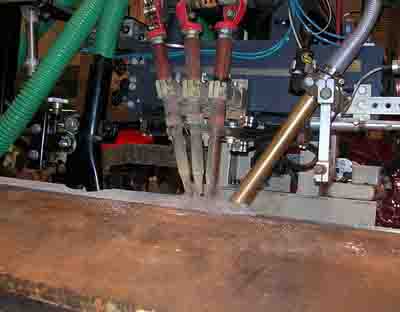
For semiautomatic application, a welding gun and cable assembly are used to carry the electrode and current and to provide the flux at the arc.
A small flux hopper is attached to the end of the cable assembly.
The electrode wire is fed through the bottom of this flux hopper through a current pickup tip to the arc.
The flux is fed from the hopper to the welding area by means of gravity.
The amount of flux fed depends on how high the gun is held above the work.
The hopper gun may include a start switch to initiate the weld or it may utilize a “hot” electrode so that when the electrode is touched to the work, feeding will begin automatically.
For automatic welding, the torch is attached to the wire feed motor and includes current pickup tips for transmitting the welding current to the electrode wire.
The flux hopper is normally attached to the torch, and may have magnetically operated valves which can be opened or closed by the control system.
Other pieces of equipment sometimes used may include a travel carriage, which can be a simple tractor or a complex moving specialized fixture. A flux recovery unit is normally provided to collect the unused submerged arc flux and return it to the supply hopper.
Submerged arc welding system can become quite complex by incorporating additional devices such as seam followers, weavers, and work rovers.
SAW Welding Diagram
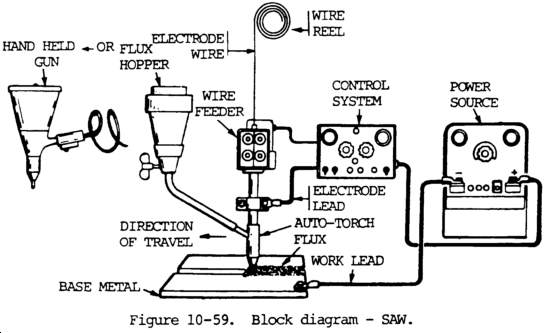
Advantages of SAW
The major advantages of the SAW or submerged arc welding process are:
- high quality metal weld.
- extremely high speed and deposition rate
- smooth, uniform finished weld with no spatter.
- little or no smoke.
- no arc flash, thus minimal need for protective clothing.
- high utilization of electrode wire.
- easy automation for high-operator factor.
- normally, no involvement of manipulative skills.
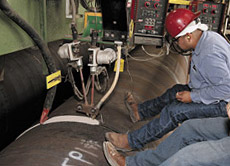
Major Uses of SAW
The submerged arc process is widely used in heavy steel plate fabrication work. This includes the welding of:
- structural shapes
- the longitudinal seam of larger diameter pipe
- the manufacture of machine components for all types of heavy industry,
- the manufacture of vessels and tanks for pressure and storage use
It is widely used in the shipbuilding industry for splicing and fabricating sub-assemblies, and by many other industries where steels are used in medium to heavy thicknesses.
It is also used for surfacing and buildup work, maintenance, and repair.
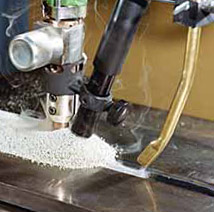
Process Limitations
A major limitation of SAW (submerged arc welding) is its limitation of welding positions. The other limitation is that it is primarily used only to weld mild and low-alloy high-strength steels.
The high-heat input and slow-cooling cycle can be a problem when welding quenched and tempered steels. The heat input limitation of the steel in question must be strictly adhered to when using submerged arc welding.
This may require the making of multipass welds where a single pass weld would be acceptable in mild steel. In some cases, the economic advantages may be reduced to the point where flux-cored arc welding or some other process should be considered.
In semiautomatic submerged arc welding, the inability to see the arc and puddle can be a disadvantage in reaching the root of a groove weld and properly filling or sizing.
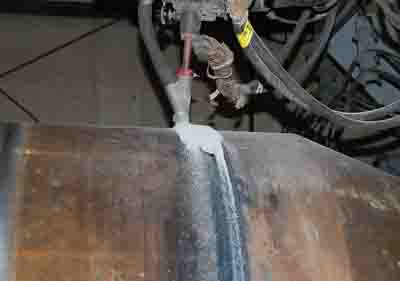
Principles of Operation
Process
The submerged arc welding process is shown by figure 10-60. It utilizes the heat of an arc between a continuously fed electrode and the work.
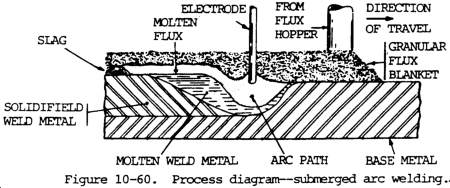
The heat of the arc melts the surface of the base metal and the end of the electrode. The metal melted off the electrode is transferred through the arc to the workpiece, where it becomes the deposited weld metal.
Shielding is obtained from a blanket of granular flux, which is laid directly over the weld area. The flux close to the arc melts and intermixes with the molten weld metal, helping to purify and fortify it.
The flux forms a glass-like slag that is lighter in weight than the deposited weld metal and floats on the surface as a protective cover.
The weld is submerged under this layer of flux and slag, hence the name submerged arc welding. The flux and slag normally cover the arc so that it is not visible.
The unmelted portion of the flux can be reused. The electrode is fed into the arc automatically from a coil. The arc is maintained automatically.
Travel can be manual or by machine. The arc is initiated by a fuse type start or by a reversing or retrack system.
Normal Method of Application and Position Capabilities
The most popular method of SAW application is the machine method, where the operator monitors the welding operation.
Second in popularity is the automatic method, where welding is a pushbutton operation. The process can be applied semiautomatically; however, this method of application is not too popular.
The process cannot be applied manually because it is impossible for a welder to control an arc that is not visible. The submerged arc welding process is a limited-position welding process.
The welding positions are limited because the large pool of molten metal and the slag are very fluid and will tend to run out of the joint. Welding can be done in the flat position and in the horizontal fillet position with ease.
Under special controlled procedures, it is possible to weld in the horizontal position, sometimes called 3 o’clock welding.
This requires special devices to hold the flux up so that the molten slag and weld metal cannot run away. The process cannot be used in the vertical or overhead position.
Metals Weldable and Thickness Range
Submerged arc welding is used to weld low- and medium-carbon steels, low-alloy high-strength steels, quenched and tempered steels, and many stainless steels.
Experimentally, it has been used to weld certain copper alloys, nickel alloys, and even uranium.
Metal thicknesses from 1/16 to 1/2 in. (1.6 to 12.7 mm) can be welded with no edge preparation. With edge preparation, welds can be made with a single pass on material from 1/4 to 1 in. (6.4 to 25.4 mm).
When the multipass technique is used, the maximum thickness is practically unlimited. This information is summarized in table 10-22. Horizontal fillet welds can be made up to 3/8 in. (9.5 mm) in a single pass and in the flat position, fillet welds can be made up to 1 in. (25 mm) size.
Joint Design
Although the submerged arc welding process can utilize the same joint design details as the shielded metal arc welding process, different joint details are suggested for maximum utilization and efficiency of submerged arc welding. For groove welds, the square groove design can be used up to 5/8 in. (16 mm) thickness.
Beyond this thickness, bevels are required. Open roots are used but backing bars are necessary since the molten metal will run through the joint.
When welding thicker metal, if a sufficiently large root face is used, the backing bar may be eliminated. However, to assure full penetration when welding from one side, backing bars are recommended. Where both sides are accessible, a backing weld can be made which will fuse into the original weld to provide full penetration.
Welding Circuit and Current
The SAW or submerged arc welding process uses either direct or alternating current for welding power. Direct current is used for most applications that use a single arc. Both direct current electrode positive (DCEP) and electrode negative (DCEN) are used.
The constant voltage type of direct current power is more popular for submerged arc welding with 1/8 in. (3.2 mm) and smaller diameter electrode wires.
The constant current power system is normally used for welding with 5/3 2 in. (4 mm) and larger-diameter electrode wires. The control circuit for CC power is more complex since it attempts to duplicate the actions of the welder to retain a specific arc length. The wire feed system must sense the voltage across the arc and feed the electrode wire into the arc to maintain this voltage. As conditions change, the wire feed must slow down or speed up to maintain the prefixed voltage across the arc. This adds complexity to the control system. The system cannot react instantaneously. Arc starting is more complicated with the constant current system since it requires the use of a reversing system to strike the arc, retract, and then maintain the preset arc voltage.
For SAW ac welding, the constant current power is always used. When multiple electrode wire systems are used with both ac and dc arcs, the constant current power system is utilized. The constant voltage system, however, can be applied when two wires are fed into the arc supplied by a single power source. Welding current for submerged arc welding can vary from as low as 50 amperes to as high as 2000 amperes. Most submerged arc welding is done in the range of 200 to 1200 amperes.
Deposition Rates and Weld Quality
The deposition rates of the submerged arc welding process are higher than any other arc welding process. Deposition rates for single electrodes are shown by figure 10-62. There are at least four related factors that control the deposition rate of submerged arc welding: polarity, long stickout, additives in the flux, and additional electrodes. The deposition rate is the highest for direct current electrode negative (DCEN). The deposition rate for alternating current is between DCEP and DCEN. The polarity of maximum heat is the negative pole.
The deposition rate with any welding current can be increased by extending the “stickout.” This is the distance from the point where current is introduced into the electrode to the arc. When using “long stickout” the amount of penetration is reduced. The deposition rates can be increased by metal additives in the submerged arc flux. Additional electrodes can be used to increase the overall deposition rate.
The quality of the weld metal deposited by the submerged arc welding process is high. The weld metal strength and ductility exceeds that of the mild steel or low-alloy base material when the correct combination of electrode wire and submerged arc flux is used. When submerged arc welds are made by machine or automatically, the human factor inherent to the manual welding processes is eliminated. The weld will be more uniform and free from inconsistencies. In general, the weld bead size per pass is much greater with submerged arc welding than with any of the other arc welding processes. The heat input is higher and cooling rates are slower. For this reason, gases are allowed more time to escape. Additionally, since the submerged arc slag is lower in density than the weld metal, it will float out to the top of the weld. Uniformity and consistency are advantages of this process when applied automatically.
Several problems may occur when using the semiautomatic application method. The electrode wire may be curved when it leaves the nozzle of the welding gun. This curvature can cause the arc to be struck in a location not expected by the welder. When welding in fairly deep grooves, the curvature may cause the arc to be against one side of the weld joint rather than at the root. This will cause incomplete root fusion. Flux will be trapped at the root of the weld. Another problem with semiautomatic welding is that of completely filling the weld groove or maintaining exact size, since the weld is hidden and cannot be observed while it is being made. This requires making an extra pass. In some cases, too much weld is deposited. Variations in root opening affect the travel speed. If travel speed is uniform, the weld may be under- or overfilled in different areas. High operator skill will overcome this problem.
There is another quality problem associated with extremely large single-pass weld deposits. When these large welds solidify, the impurities in the melted base metal and in the weld metal all collect at the last point to freeze, which is the centerline of the weld. If there is sufficient restraint and enough impurities are collected at this point, centerline cracking may occur. This can happen when making large single-pass flat fillet welds if the base metal plates are 45º from flat. A simple solution is to avoid placing the parts at a true 45º angle. It should be varied approximately 10º so that the root of the joint is not in line with the centerline of the fillet weld. Another solution is to make multiple passes rather than attempting to make a large weld in a single pass.
Another quality problem has to do with the hardness of the deposited weld metal. Excessively hard weld deposits contribute to cracking of the weld during fabrication or during service. A maximum hardness level of 225 Brinell is recommended. The reason for the hard weld in carbon and low-alloy steels is too rapid cooling, inadequate postweld treatment, or excessive alloy pickup in the weld metal. Excessive alloy pickup is due to selecting an electrode that has too much alloy, selecting a flux that introduces too much alloy into the weld, or the use of excessively high welding voltages.
In automatic and machine welding, defects may occur at the start or at the end of the weld. The best solution is to use runout tabs so that starts and stops will be on the tabs rather than on the product.
Weld Schedules
The submerged arc welding process applied by machine or fully automatically should be done in accordance with welding procedure schedules. All of the welds made by this procedure should pass qualification, tests, assuming that the correct electrode and flux have been selected. If the schedules are varied more than 10 percent, qualification tests should be performed to determine the weld quality.
Welding Variables
The welding variables for submerged arc welding are similar to the other arc welding processes, with several exceptions.
In submerged arc welding, the electrode type and the flux type are usually based on the mechanical properties required by the weld. The electrode size is related to the weld joint size and the current recommended for the particular joint. This must also be considered in determining the number of passes or beads for a particular joint. Welds for the same joint dimension can be made in many or few passes, depending on the weld metal metallurgy desired. Multiple passes usually deposit higher-quality weld metal. Polarity is established initially and is based on whether maximum penetration or maximum deposition rate is required.
The major variables that affect the weld involve heat input and include the welding current, arc voltage, and travel speed. Welding current is the most important. For single-pass welds, the current should be sufficient for the desired penetration without burn-through. The higher the current, the deeper the penetration. In multi-pass work, the current should be suitable to produce the size of the weld expected in each pass. The welding current should be selected based on the electrode size. The higher the welding current, the greater the melt-off rate (deposition rate).
The arc voltage is varied within narrower limits than welding current. It has an influence on the bead width and shape. Higher voltages will cause the bead to be wider and flatter. Extremely high arc voltage should be avoided, since it can cause cracking. This is because an abnormal amount of flux is melted and excess deoxidizers may be transferred to the weld deposit, lowering its ductility. Higher arc voltage also increases the amount of flux consumed. The low arc voltage produces a stiffer arc that improves penetration, particularly in the bottom of deep grooves. If the voltage is too low, a very narrow bead will result. It will have a high crown and the slag will be difficult to remove.
Travel speed influences both bead width and penetration. Faster travel speeds produce narrower beads that have less penetration. This can be an advantage for sheet metal welding where small beads and minimum penetration are required. If speeds are too fast, however, there is a tendency for undercut and porosity, since the weld freezes quicker. If the travel speed is too slow, the electrode stays in the weld puddle too long. This creates poor bead shape and may cause excessive spatter and flash through the layer of flux.
The secondary variables include the angle of the electrode to the work, the angle of the work itself, the thickness of the flux layer, and the distance between the current pickup tip and the arc. This latter factor, called electrode “stickout,” has a considerable effect on the weld. Normally, the distance between the contact tip and the work is 1 to 1-1/2 in. (25 to 38 mm). If the stickout is increased beyond this amount, it will cause preheating of the electrode wire, which will greatly increase the deposition rate. As stickout increases, the penetration into the base metal decreases. This factor must be given serious consideration because in some situations the penetration is required.
The depth of the flux layer must also be considered. If it is too thin, there will be too much arcing through the flux or arc flash. This also may cause porosity. If the flux depth is too heavy, the weld may be narrow and humped. Too many small particles in the flux can cause surface pitting since the gases generated in the weld may not be allowed to escape. These are sometimes called peck marks on the bead surface.
Tips for Using the Process
One of the major applications for submerged arc welding is on circular welds where the parts are rotated under a fixed head. These welds can be made on the inside or outside diameter. Submerged arc welding produces a large molten weld puddle and molten slag which tends to run. This dictates that on outside diameters, the electrode should be positioned ahead of the extreme top, or 12 o’clock position, so that the weld metal will begin to solidify before it starts the downside slope. This becomes more of a problem as the diameter of the part being welded gets smaller. Improper electrode position will increase the possibility of slag entrapment or a poor weld surface. The angle of the electrode should also be changed and pointed in the direction of travel of the rotating part. When the welding is done on the inside circumference, the electrode should be angled so that it is ahead of bottom center, or the 6 o’clock position.
Sometimes the work being welded is sloped downhill or uphill to provide different types of weld bead contours. If the work is sloped downhill, the bead will have less penetration and will be wider. If the weld is sloped uphill, the bead will have deeper penetration and will be narrower. This is based on all other factors remaining the same.
The weld will be different depending on the angle of the electrode with respect to the work when the work is level. This is the travel angle, which can be a drag or push angle. It has a definite effect on the bead contour and weld metal penetration.
One side welding with complete root penetration can be obtained with submerged arc welding. When the weld joint is designed with a tight root opening and a fairly large root face, high current and electrode positive should be used. If the joint is designed with a root opening and a minimum root face, it is necessary to use a backing bar, since there is nothing to support the molten weld metal. The molten flux is very fluid and will run through narrow openings. If this happens, the weld metal will follow and the weld will burn through the joint. Backing bars are needed whenever there is a root opening and a minimum root face.
Copper backing bars are useful when welding thin steel. Without backing bars, the weld would tend to melt through and the weld metal would fall away from the joint. The backing bar holds the weld metal in place until it solidifies. The copper backing bars may be water cooled to avoid the possibility of melting and copper pickup in the weld metal. For thicker materials, the backing may be submerged arc flux or other specialized type flux.
Variations of the SAW Process
There are a large number of variations to the process that give submerged arc welding additional capabilities. Some of the more popular variations are:
- Two-wire systems–same power source.
- Two-wire systems–separate power source.
- Three-wire systems–separate power source.
- Strip electrode for surfacing.
- Iron powder additions to the flux.
- Long stickout welding.
- Electrically “cold” filler wire.
Multi-wire Systems
The multi-wire systems offer advantages since deposition rates and travel speeds can be improved by using more electrodes. Figure 10-68 shows the two methods of utilizing two electrodes, one with a single-power source and one with two power sources. When a single-power source is used, the same drive rolls are used for feeding both electrodes into the weld. When two power sources are used, individual wire feeders must be used to provide electrical insulation between the two electrodes. With two electrodes and separate power, it is possible to utilize different polarities on the two electrodes or to utilize alternating current on one and direct current on the other. The electrodes can be placed side by side. This is called the transverse electrode position. They can also be placed one in front of the other in the tandem electrode position.
Two-wire Tandem
The two-wire tandem electrode position with individual power sources is used where extreme penetration is required. The leading electrode is positive with the trailing electrode negative. The first electrode creates a digging action and the second electrode fills the weld joint. When two dc arcs are in close proximity, there is a tendency for arc interference between them. In some cases, the second electrode is connected to alternating current to avoid the interaction of the arc.
Three-wire Tandem System
The three-wire tandem system normally uses ac power on all three electrodes connected to three-phase power systems. These systems are used for making high-speed longitudinal seams for large-diameter pipe and for fabricated beams. Extremely high currents can be used with correspondingly high travel speeds and deposition rates.
The Strip Welding System
The strip welding system is used to overlay mild and alloy steels usually with stainless steel. A wide bead is produced that has a uniform and minimum penetration. This process variation is shown by figure 10-69. It is used for overlaying the inside of vessels to provide the corrosion resistance of stainless steel while utilizing the strength and economy of the low-alloy steels for the wall thickness. A strip electrode feeder is required and special flux is normally used. When the width of the strip is over 2 in. (51 mm), a magnetic arc oscillating device is used to provide for even burn-off of the strip and uniform penetration.
Other Options
Another way of increasing the deposition rate of submerged arc welding is to add iron base ingredients to the joint under the flux. The iron in this material will melt in the heat of the arc and will become part of the deposited weld metal. This increases deposition rates without decreasing weld metal properties. Metal additives can also be used for special surfacing applications. This variation can be used with single-wire or multi-wire installations.
Another variation is the use of an electrically “cold” filler wire fed into the arc area. The “cold” filler rod can be solid or flux-cored to add special alloys to the weld metal. By regulating the addition of the proper material, the properties of the deposited weld metal can be improved. It is possible to utilize a flux-cored wire for the electrode, or for one of the multiple electrodes to introduce special alloys into the weld metal deposit. Each of these variations requires special engineering to ensure that the proper material is added to provide the desired deposit properties.
Typical Applications
The submerged arc welding process is widely used in the manufacture of most heavy steel products. These include pressure vessels, boilers, tanks, nuclear reactors, chemical vessels, etc. Another use is in the fabrication of trusses and beams. It is used for welding flanges to the web. The heavy equipment industry is a major user of submerged arc welding.
Materials Used
Two materials are used in submerged arc welding: the welding flux and the consumable electrode wire.
Submerged arc welding flux shields the arc and the molten weld metal from the harmful effects of atmospheric oxygen and nitrogen. The flux contains deoxidizers and scavengers which help to remove impurities from the molten weld metal. Flux also provides a means of introducing alloys into the weld metal. As this molten flux cools to a glassy slag, it forms a covering that protects the surface of the weld. The unmelted portion of the flux does not change its form and its properties are not affected, so it can be recovered and reused. The flux that does melt and forms the slag covering must be removed from the weld bead. This is easily done after the weld has cooled. In many cases, the slag will actually peel without requiring special effort for removal. In groove welds, the solidified slag may have to be removed by a welder’s chipping hammer.
Fluxes are designed for specific applications and for specific types of weld deposits. Submerged arc fluxes come in different particle sizes. Many fluxes are not marked for size of particles because the size is designed and produced for the intended application.
There is no specification for submerged arc fluxes in use in North America. A method of classifying fluxes, however, is by means of the deposited weld metal produced by various combinations of electrodes and proprietary submerged arc fluxes. This is covered by the American Welding Society Standard. Bare carbon steel electrodes and fluxes for submerged arc welding. In this way, fluxes can be designated to be used with different electrodes to provide the deposited weld metal analysis that is desired.
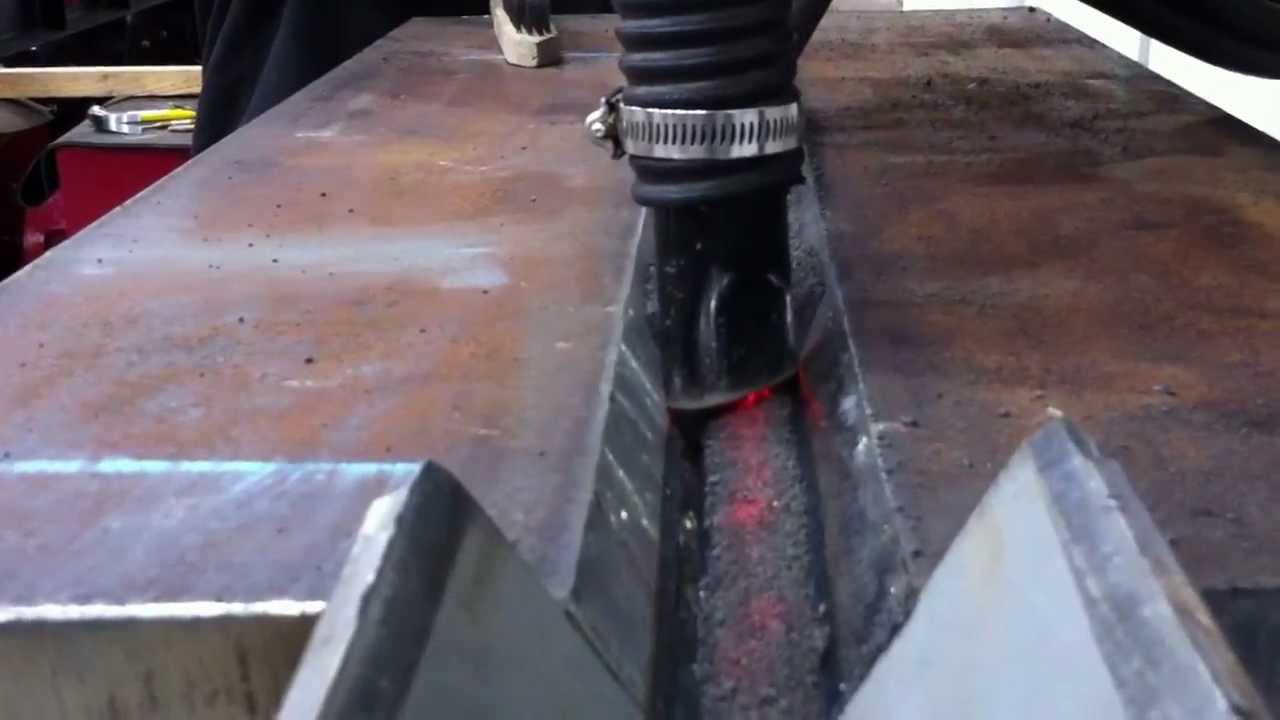
Excellent Documentation. I am using this for my classes for teaching M.Tech – Manufacturing students at IIT/ISM, Dhanbad, India.
Best wishes.